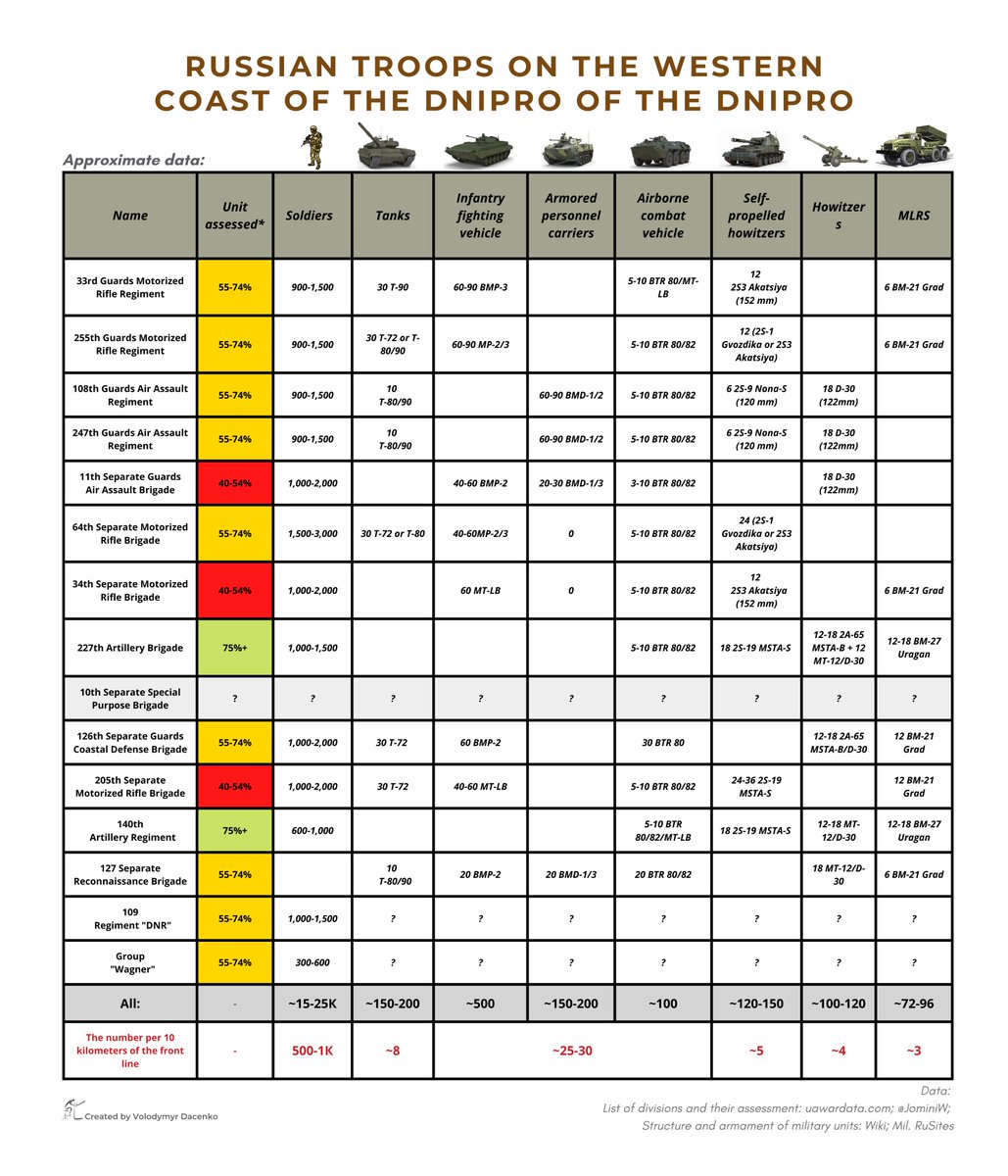
What forces does Russia have on the western bank of the Dnipro?
Are there enough Ukrainian troops to attack? 1/17
#RussiaUkraineWar #Kherson #KhersonCounteroffensive @KofmanMichael @IAPonomarenko @JominiW @HN_Schlottman @DefMon3 @daxe #OSINT
Are there enough Ukrainian troops to attack? 1/17
#RussiaUkraineWar #Kherson #KhersonCounteroffensive @KofmanMichael @IAPonomarenko @JominiW @HN_Schlottman @DefMon3 @daxe #OSINT

2/17 There are different assumptions about what is currently being will happen near Kherson.
Someone is talking about an attack on Kherson. Someone is about probing weak spots in the RU defense. Someone claims that the counterattack "failed" (@JulianRoepcke).
Someone is talking about an attack on Kherson. Someone is about probing weak spots in the RU defense. Someone claims that the counterattack "failed" (@JulianRoepcke).
3/17 If Ukraine planned to attack Kherson, it probably would not have talked so much about this offensive in the last 2 months.
All this time we have seen informational pressure. "It will start very soon". Now it has turned into military pressure.
All this time we have seen informational pressure. "It will start very soon". Now it has turned into military pressure.
4/17 Rather, this is an attempt to create conditions for Russia in which it would be impractical to maintain a combat-ready group on the right bank of the Dnipro. It's similar to what we saw on Snake Island.
5/17 First, supply routes will be put in jeopardy. Then the enemy troops are exhausted by systematic strikes. At a certain moment, the enemy decides to retreat.
6/17 In general, counteroffensive actions on the right bank of the Kherson region can have many goals.
7/17 First of all, it is beneficial for Ukraine to shift the focus of hostilities and draw the enemy's resources to the Kherson, rather than direct all forces to the Donetsk Region, where the enemy has short and protected supply routes.
8/17 Secondly, in the Kherson region, the enemy has many "beaten" units. Some of them fought in the Kyiv region. They have lower motivation and ability to recover than fresher troops in the East, where the main reserves and replenishments were directed.
9/17 Many have already tried to free themselves in these units sibreal.org/a/sotnyam-boyt…
10/17 Thirdly, in recent months, Russia has developed a strategy that has significantly reduced losses among the regular military units of the RFA: the first line of attack in the Donbas is most often made up of "LDNR" and "Wagner", whose losses do not particularly concern Putin
11/17 Regular Russian units mostly go in the second line of attack and provide cover. And they will not suffer such losses as in March-May.
Kherson Oblast is home to troops RFA (with the exception of a few units).
Kherson Oblast is home to troops RFA (with the exception of a few units).
12/17 I used maps @JominiW and uawardata.com, and information about these units in open sources, in order to understand how many weapons and soldiers Russia has on the west bank of the Dnipro.
13/17 These are about 15-25 thousand soldiers, 200 tanks, 700 armored vehicles, and 300 artillery systems. This is approximately the same as the entire military aid to Ukraine for 6 months.
14/ In order to support these Russian troops, it is necessary to provide up to 500 trucks per day with ammunition, provisions, ammunition.
If we take as a basis 2 points of crossings across the Dnipro, then it turns out that 10 trucks must pass through each crossing every minute
If we take as a basis 2 points of crossings across the Dnipro, then it turns out that 10 trucks must pass through each crossing every minute
15/17 The wounded will also be a big problem for Russia. Kherson hospitals will be able to accept some of them. But the majority must be transported to Crimea.
16/17 It is also obvious that Russia has lost part of its air defense systems, which allows more active use of Ukrainian aviation and UAVs.
17/17 It is still too early to talk about the prospects of the offensive. A lot depends on the morale of Russian soldiers. Will they be ready to continue the battle in conditions of poor supplies, shortage of normal food, and medical care...
Addition: 1) A good video about what is happening in the Kherson region now and what to expect from the offensive: "Offensive without frontal attacks. The battles for Kherson will be tough"
Unfortunately, there are no English subtitles.
Unfortunately, there are no English subtitles.
2) Key conclusions: the advance is gradual, there are many wounded, because Russia uses massed artillery fire, the enemy is entrenched in every settlement and a quick breakthrough is impossible. The military is oriented not on days and weeks, but on 2 months.
3) During the storming of one of the settlements, there were about 30 wounded per day. These are almost always shrapnel injuries. The military says that everyone survived. Much depends on whether it will be possible to limit the supply of shells through the Dnipro.
4) It is also noted that the enemy continues to transfer forces and now there may be significantly more forces than estimated. Talking about 49 BTG, which have already been moved to the right bank or are waiting for it.
5) In the video, no one expects urban battles for Kherson. If Ukrainian forces managed to reach the Dnipro from the north, Kherson would turn into an island. It will make no sense for the Russians to defend it.
• • •
Missing some Tweet in this thread? You can try to
force a refresh









